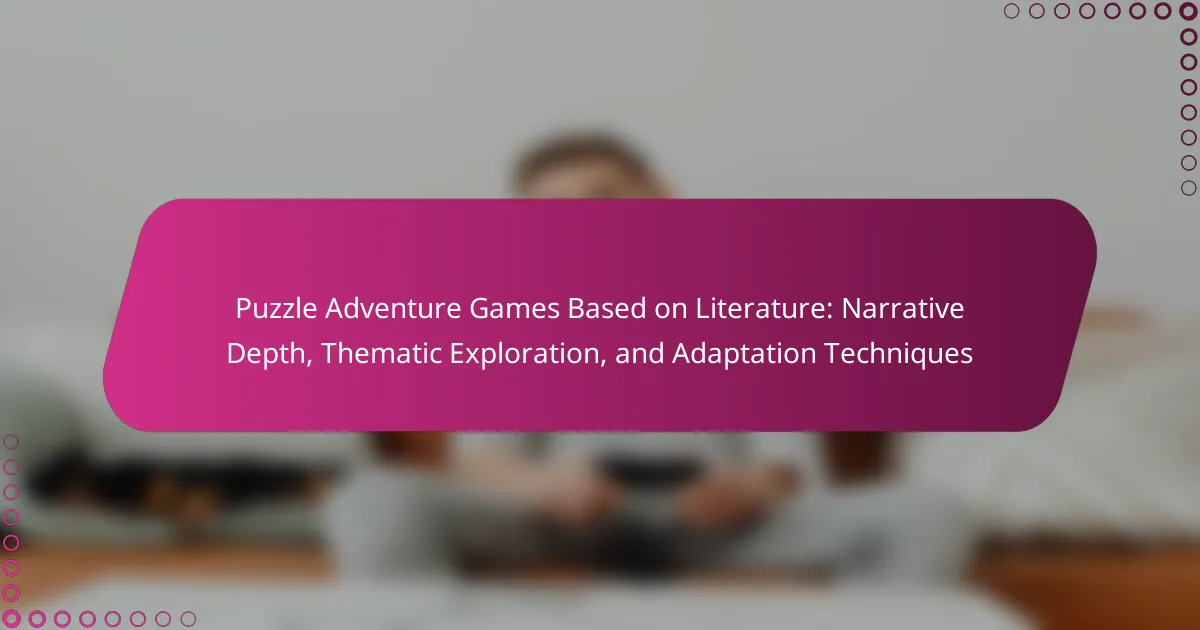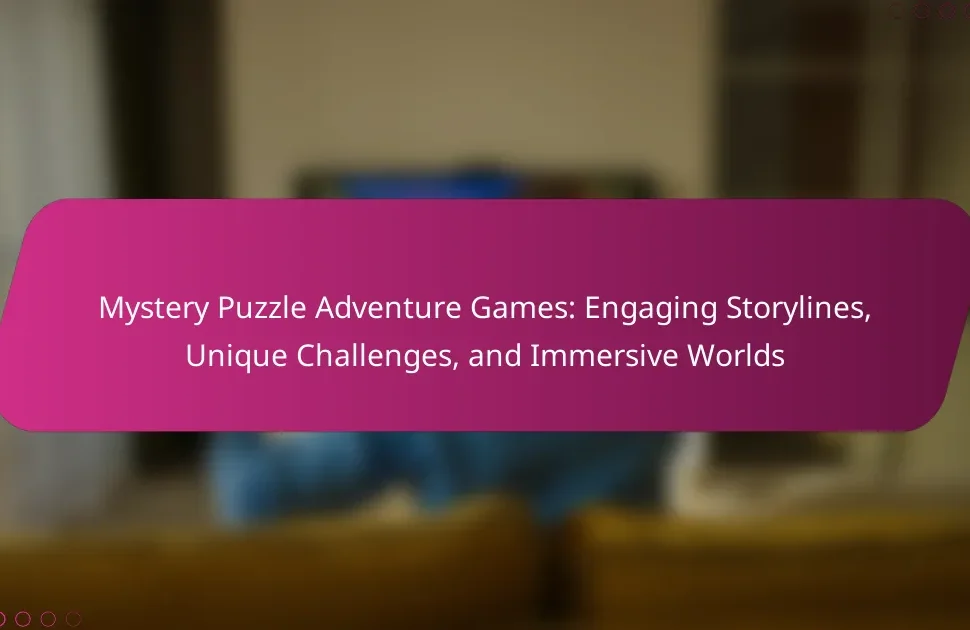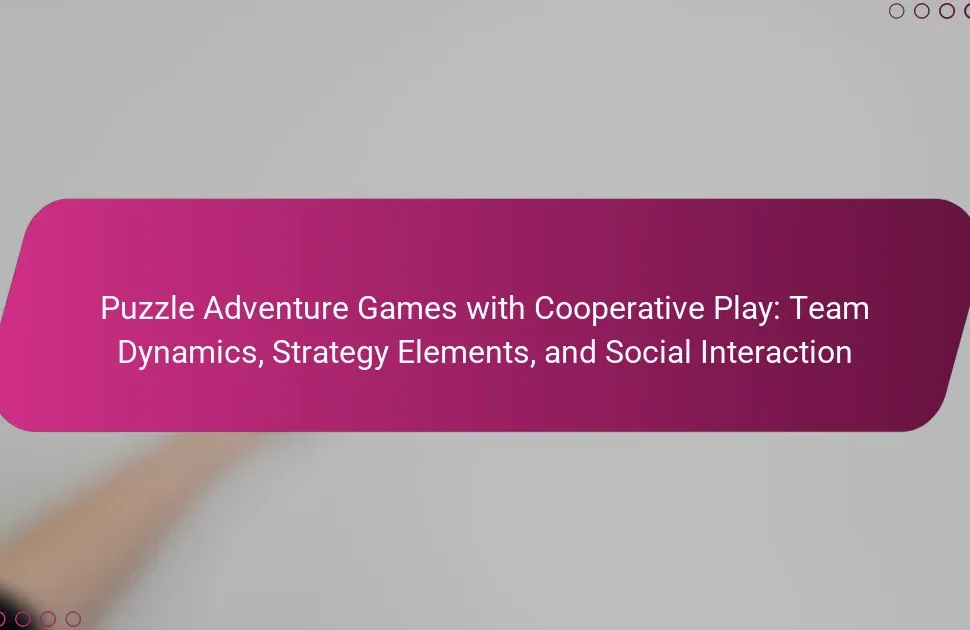Puzzle adventure games based on literature offer players a unique way to engage with classic narratives. These games explore narrative depth, thematic exploration, and innovative adaptation techniques. Players navigate immersive environments while solving puzzles that reflect the source material’s complexity. Notable examples highlight the emotional connections and player choices that shape the storytelling experience.

What are Puzzle Adventure Games Based on Literature?
Puzzle adventure games based on literature combine storytelling with interactive gameplay. These games adapt classic narratives, allowing players to explore themes and characters in immersive environments. They often feature puzzles that reflect the source material’s depth, enhancing engagement. Notable examples include “The Secret of Monkey Island,” which draws inspiration from pirate lore, and “The Book of Unwritten Tales,” which incorporates fantasy elements. These adaptations showcase unique techniques, such as narrative branching and character development, enriching the player’s experience.
How do they differ from traditional puzzle games?
Puzzle adventure games differ from traditional puzzle games by integrating narrative depth and thematic exploration. Traditional puzzle games focus primarily on solving discrete challenges, while puzzle adventure games weave puzzles into a broader story, enhancing player engagement. They utilize adaptation techniques to bring literary elements to life, offering unique attributes such as character development and immersive environments. This combination creates a richer gameplay experience that encourages emotional investment and critical thinking.
What role does narrative play in these games?
Narrative plays a crucial role in puzzle adventure games by enriching the player’s experience and enhancing thematic exploration. These games often adapt literary works, weaving complex stories that engage players emotionally. Through character development and plot progression, players are drawn into immersive worlds that challenge their problem-solving skills while exploring deeper themes. The narrative depth often reflects unique attributes of the source material, providing a fresh perspective and encouraging players to think critically about the story.
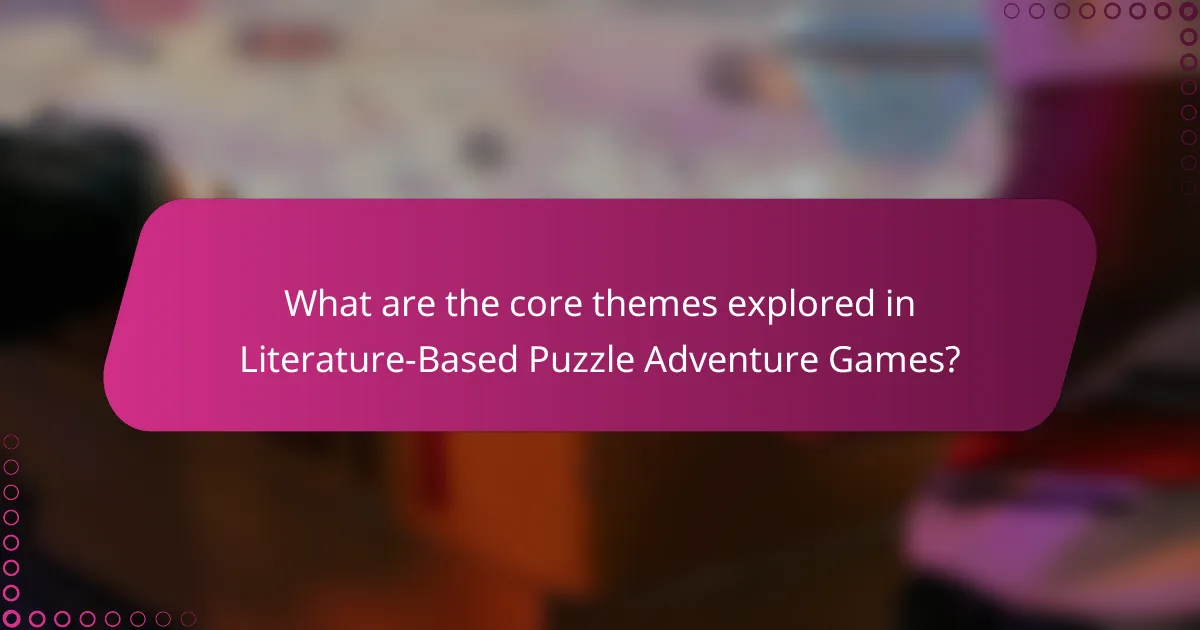
What are the core themes explored in Literature-Based Puzzle Adventure Games?
Puzzle adventure games based on literature explore themes such as identity, morality, and the human experience. These games adapt complex narratives, engaging players in immersive storytelling while challenging them with puzzles. They often reflect the source material’s themes, enhancing the player’s understanding of the literary work. Additionally, they utilize unique adaptation techniques, transforming text into interactive experiences that resonate emotionally with players.
How do themes of identity and self-discovery manifest?
Themes of identity and self-discovery prominently manifest in puzzle adventure games through character development and narrative choices. Players often engage with complex characters whose journeys reflect personal growth and existential questions. The adaptation of literary works enhances this exploration, allowing players to navigate themes like belonging and self-acceptance.
In these games, players solve puzzles that symbolize internal conflicts, leading to moments of revelation. The interactive nature of gameplay fosters a deeper connection to the characters’ struggles, making the experience more immersive. As players progress, they uncover layers of identity, prompting reflection on their own self-discovery.
Moreover, the narrative depth supports varied interpretations of identity, allowing players to relate to the characters in unique ways. This adaptability creates a rich tapestry of themes that resonate with diverse audiences, highlighting the universal quest for understanding oneself.
Overall, puzzle adventure games based on literature effectively intertwine narrative depth with themes of identity, offering players a profound journey of self-exploration.
What cultural and historical themes are prevalent?
Puzzle adventure games based on literature often explore themes of identity, morality, and the human experience. These games adapt classic narratives, immersing players in rich storylines that reflect cultural values and historical contexts. For example, adaptations of works like “Alice’s Adventures in Wonderland” delve into themes of curiosity and absurdity, while “The Picture of Dorian Gray” examines vanity and consequence. Such games encourage players to engage with complex narratives, enhancing their understanding of both the source material and its broader cultural implications.
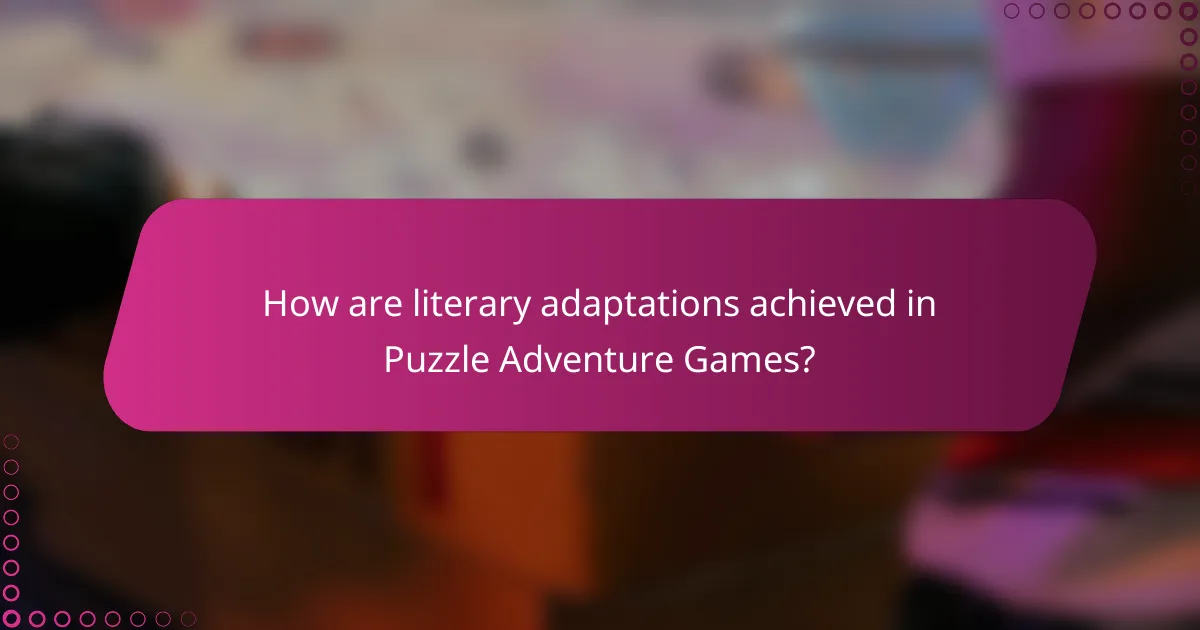
How are literary adaptations achieved in Puzzle Adventure Games?
Literary adaptations in puzzle adventure games are achieved through narrative depth, thematic exploration, and specific adaptation techniques. Developers analyze source material to create immersive storylines that resonate with players. They often incorporate key themes and character arcs, ensuring fidelity to the original work while allowing for interactive gameplay. Unique puzzles reflect literary elements, enhancing engagement and understanding of the narrative. Techniques such as visual storytelling and environmental cues further enrich the player experience, making literature accessible and enjoyable.
What techniques are used for narrative adaptation?
Puzzle adventure games utilize various techniques for narrative adaptation, enhancing engagement and thematic depth. These techniques include character-driven storytelling, immersive world-building, and interactive dialogue systems.
Character-driven storytelling allows players to connect emotionally with the narrative, often through well-developed protagonists and antagonists. Immersive world-building creates rich environments that reflect the source material’s themes and settings. Interactive dialogue systems enable players to influence the story’s direction, fostering a sense of agency.
Additionally, puzzles often reflect narrative elements, intertwining gameplay with story progression. This integration deepens the player’s experience and understanding of the adapted literature, making the narrative more impactful.
How do developers balance fidelity to source material and gameplay innovation?
Developers balance fidelity to source material and gameplay innovation by integrating narrative elements while allowing creative freedom. Adapting literary works often involves retaining core themes and character arcs, ensuring players experience familiar storylines. However, gameplay mechanics must evolve to engage modern audiences, introducing puzzles and challenges that enhance interactivity. This dual focus on narrative depth and innovative design fosters immersive experiences that resonate with both literary fans and gamers alike.
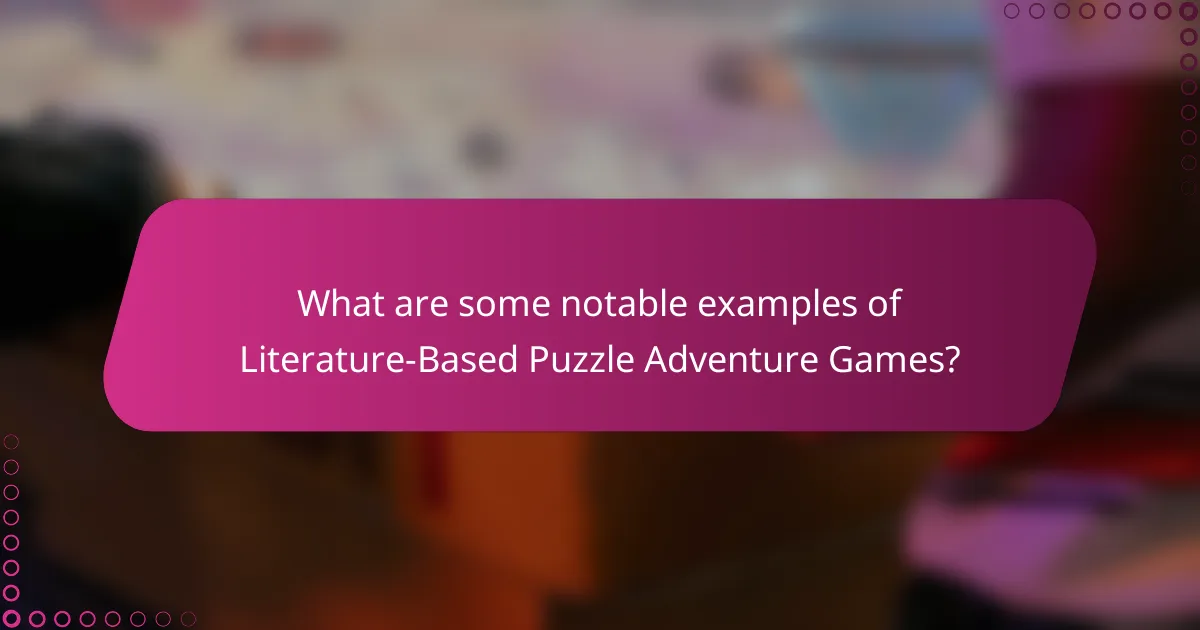
What are some notable examples of Literature-Based Puzzle Adventure Games?
Notable examples of literature-based puzzle adventure games include “The Secret of Monkey Island,” “Grim Fandango,” and “The Book of Unwritten Tales.” These games adapt rich narratives and themes from classic literature, enhancing player engagement through immersive storytelling and intricate puzzles. “The Secret of Monkey Island” draws on pirate lore, while “Grim Fandango” incorporates elements of Mexican folklore. “The Book of Unwritten Tales” cleverly blends various literary references into its gameplay, showcasing the versatility of narrative adaptation in gaming.
Which games have received critical acclaim for their storytelling?
Several puzzle adventure games based on literature have received critical acclaim for their storytelling. Notable examples include “The Secret of Monkey Island,” praised for its humour and character development, and “Grim Fandango,” known for its unique narrative and cultural references. “Life is Strange” stands out for its emotional depth and player-driven choices, while “Oxenfree” captivates players with its dialogue system and supernatural elements. “The Last Express” offers a rich historical context and intricate plot, making it a significant title in narrative gaming. Each of these games effectively combines thematic exploration with innovative adaptation techniques, enhancing their storytelling impact.
What unique mechanics do these games introduce?
Puzzle adventure games based on literature introduce unique mechanics that enhance narrative engagement and thematic depth. These games often utilize branching dialogue systems, allowing players to influence story outcomes. They may also incorporate environmental puzzles that reflect literary themes, creating immersive gameplay experiences. Additionally, some games feature character development mechanics tied to literary archetypes, deepening player connection to the narrative. These approaches differentiate them from traditional puzzle games, emphasizing storytelling as a core gameplay element.

How do player choices impact narrative outcomes in these games?
Player choices significantly shape narrative outcomes in puzzle adventure games by influencing character development, plot progression, and thematic exploration. These games often adapt literary sources, allowing players to engage with the story in unique ways. Choices can lead to multiple endings, altering character fates and revealing different thematic elements. This interactivity enhances player investment and emotional connection to the narrative, making each decision impactful. The branching storylines provide diverse experiences, encouraging replayability and deeper exploration of the source material.
What branching narrative structures are commonly used?
Common branching narrative structures in puzzle adventure games include choice-based paths, multiple endings, and character-driven arcs. These structures enhance player engagement and thematic exploration. Choice-based paths allow players to make decisions that affect the storyline, creating a unique experience. Multiple endings provide replayability, encouraging players to explore different outcomes. Character-driven arcs deepen emotional connections, enriching the narrative depth. These elements are essential for adapting literary themes into interactive formats.
How do player decisions reflect the themes of the original literature?
Player decisions in puzzle adventure games based on literature often reflect themes such as moral dilemmas, character development, and narrative choices. These games adapt literary elements by immersing players in complex storylines that challenge their understanding of the source material. For instance, choices may mirror the original characters’ struggles, enhancing thematic exploration. As a result, players experience a deeper connection to the literature, reinforcing its core messages. The unique attribute of these games lies in their ability to engage players in active storytelling, making them part of the narrative.

What challenges do developers face when creating these games?
Developers face challenges in balancing narrative depth with gameplay mechanics. Adapting literary themes requires preserving the source material’s essence while ensuring player engagement. Technical limitations can hinder the implementation of complex narratives or intricate puzzles. Additionally, audience expectations for fidelity to the original work can complicate creative decisions.
How do they ensure accessibility for diverse audiences?
Puzzle adventure games ensure accessibility for diverse audiences through inclusive design, customizable settings, and varied difficulty levels. These games often feature adjustable text sizes, colour contrast options, and audio descriptions to accommodate different needs. Additionally, they may include tutorials and hints to support players of varying skill levels. By considering these attributes, developers create engaging experiences that resonate with a broader range of players.
What are common pitfalls in adapting literary works?
Common pitfalls in adapting literary works include oversimplification, loss of narrative depth, and neglecting thematic exploration. Adapters often prioritize gameplay mechanics over character development, leading to a disconnection from the source material. Additionally, failing to recognize unique attributes of the original work can result in a diluted experience for players. Balancing fidelity to the text with engaging gameplay is crucial for a successful adaptation.
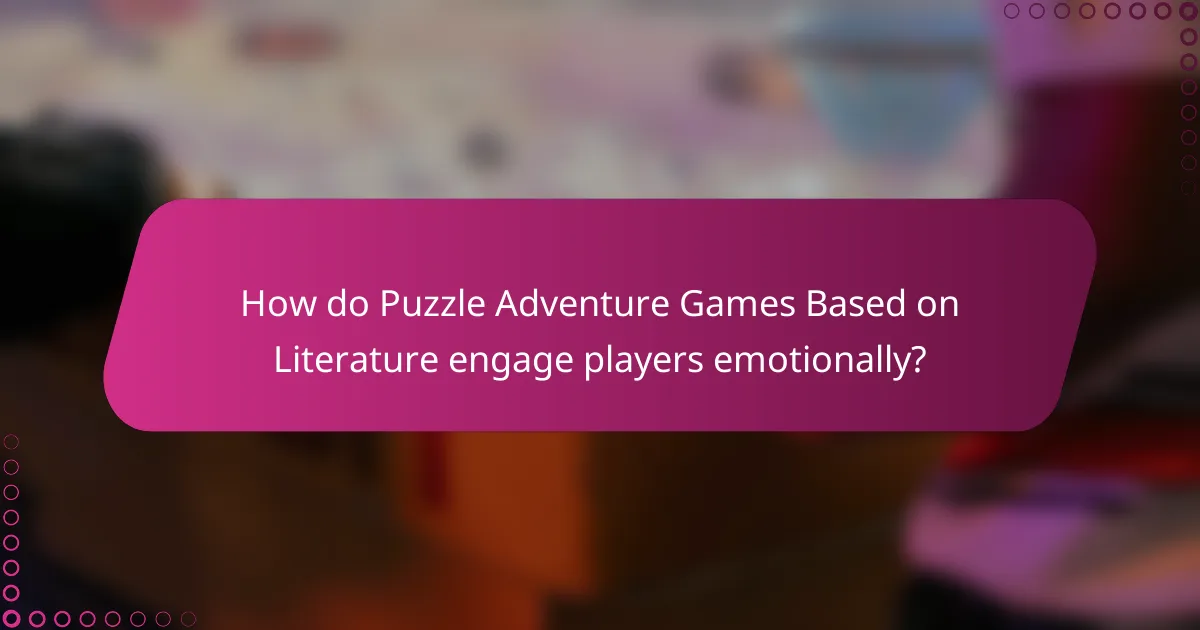
How do Puzzle Adventure Games Based on Literature engage players emotionally?
Puzzle adventure games based on literature engage players emotionally through immersive storytelling and relatable characters. These games often adapt rich narratives, allowing players to explore complex themes such as love, loss, and morality.
The narrative depth in these games fosters emotional connections, as players navigate character-driven plots that resonate with their own experiences. For example, games based on classic literature often highlight universal human struggles, enhancing player empathy.
Additionally, thematic exploration invites players to reflect on significant life questions, engaging them on a deeper level. Unique adaptation techniques, such as interactive dialogue and environmental storytelling, further enrich emotional engagement, making players feel integral to the story’s outcome.
Overall, the combination of narrative depth, thematic richness, and innovative adaptation techniques creates a compelling emotional experience in puzzle adventure games based on literature.
What role does music and art play in enhancing emotional depth?
Music and art significantly enhance emotional depth in puzzle adventure games by creating immersive experiences. They evoke feelings and set the tone, deepening player engagement with the narrative. For example, a haunting score can amplify tension during critical moments, while vibrant visuals can convey joy or hope. This synergy between audio and visual elements enriches thematic exploration, allowing players to connect with characters and stories on a profound level. Additionally, adaptive techniques in these games often use music and art to reflect player choices, making emotional responses more personalized and impactful.
How do narrative pacing and character development affect player immersion?
Narrative pacing and character development significantly enhance player immersion in puzzle adventure games. Effective pacing maintains engagement by balancing tension and resolution, allowing players to absorb story elements. Strong character development fosters emotional connections, making players invested in outcomes. Together, these elements create a rich, immersive experience that deepens thematic exploration and narrative depth.
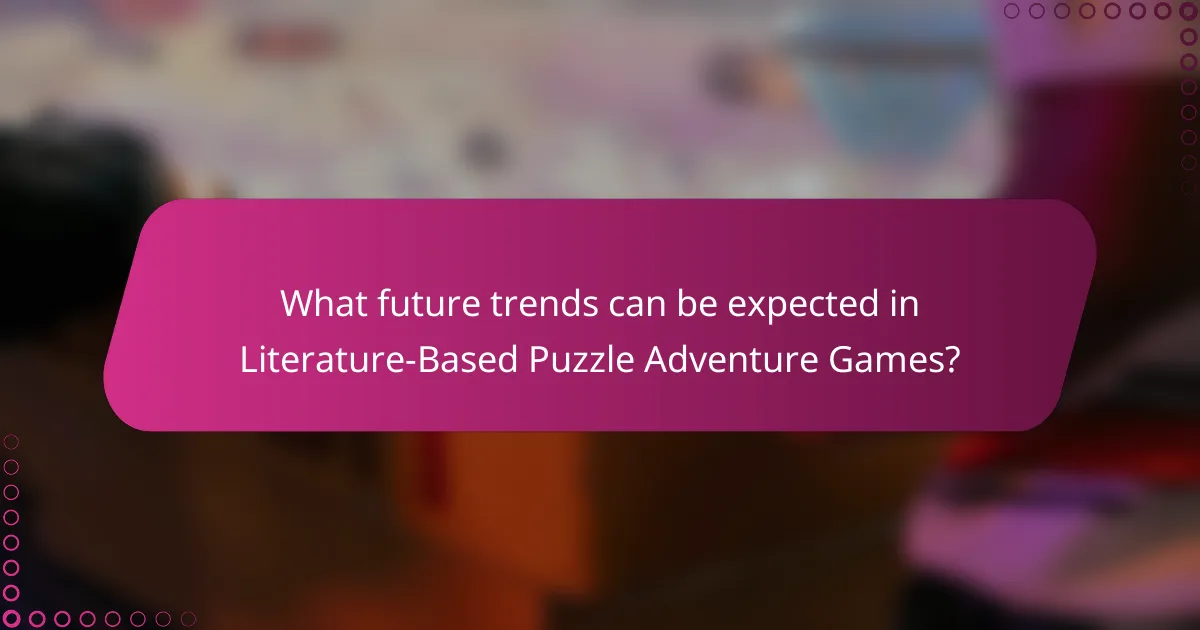
What future trends can be expected in Literature-Based Puzzle Adventure Games?
Future trends in literature-based puzzle adventure games include deeper narrative integration, innovative thematic explorations, and advanced adaptation techniques. These games will increasingly leverage immersive storytelling, allowing players to engage with complex characters and rich plots.
Developers are expected to utilize artificial intelligence to create dynamic narratives that adapt to player choices, enhancing replayability. Additionally, augmented reality features may emerge, blending the physical and digital worlds to enrich the literary experience.
Collaborations with authors and literary estates will likely lead to more authentic adaptations, preserving the essence of original works while introducing interactive elements. As a result, players can expect a more nuanced exploration of themes, fostering critical thinking and emotional engagement.
Overall, the evolution of technology and narrative design will shape the future of puzzle adventure games, making them more engaging and reflective of literary depth.
How might emerging technologies influence storytelling in these games?
Emerging technologies significantly enhance storytelling in puzzle adventure games by enabling immersive experiences. Techniques such as augmented reality and artificial intelligence create dynamic narratives that adapt to player choices. These technologies allow for deeper thematic exploration and richer character development. Additionally, they facilitate innovative adaptation techniques, transforming literary sources into interactive experiences that engage players on multiple levels.
What potential new themes could be explored in upcoming releases?
Puzzle adventure games based on literature can explore themes like existentialism, identity, and moral dilemmas. These themes deepen narrative engagement and challenge players’ perspectives. Additionally, adaptations could focus on lesser-known works, offering fresh interpretations and unique gameplay mechanics. Incorporating interactive storytelling techniques can enhance emotional connections, making the experience more immersive.
What are best practices for enjoying and engaging with these games?
To enjoy and engage with puzzle adventure games based on literature, immerse yourself in the narrative and themes. Explore the storylines deeply, as they often reflect complex literary works. Pay attention to character development and thematic elements, which enhance your understanding and enjoyment. Collaborate with others to share insights and solve puzzles collectively, enriching the experience. Finally, appreciate the adaptation techniques used, as they can provide unique interpretations of familiar texts.
